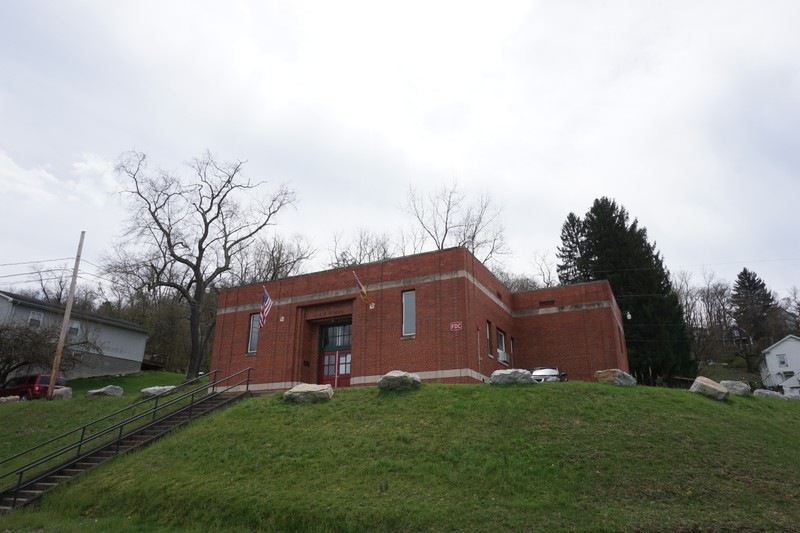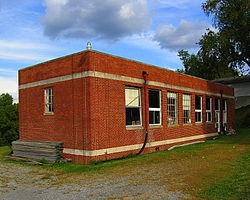Second Ward Negro Elementary
Introduction
Text-to-speech Audio
Images
Second Ward Negro Elementary.

The rear of the building.

Backstory and Context
Text-to-speech Audio
The Second Ward Negro Elementary was the result of a Works Progress Administration (WPA) grant to build twenty-one schools and additions in West Virginia. $1,034,284.31 was allotted for this purpose. Only three of the structures were intended for use as Black schools. The Charleston, West Virginia based Tucker and Sillings architectural firm designed this building, as well as the other twenty structures. At the time of the building’s construction, there was already a school building on a nearby street. However, segregated policies dictated that African Americans be educated separately from white students. The Second Ward Negro Elementary was one of the first public schools open to Black children in Monongalia County. If they received an education at all, Black students were typically educated in private homes. In fact, the ten bedroom house across the street from Second Ward Negro Elementary was once used as a type of boarding school for Black students.
The Second Ward Negro Elementary is a simple brick t-shaped structure. The symmetrical one-story building features a single hallway separating two classrooms. The classrooms were separated by folding wooden partitions that allowed the space to transform into a single large room when needed. A flat roof is broken in the center by a modest brick chimney. An unfinished basement allows access to the sandstone foundation. The only ornamentation or decorations of any kind on the exterior of the building are two courser bands of smooth sandstone. These bands wrap around the entirety of the structure with one on the top and one on the bottom of the walls. An unattributed early historical source referred to the building as Art Deco in style, a misconception which continues to plague descriptions of the building. While the Works Progress Administration did frequently construct Art Deco architecture, this structure is only vaguely similar to the WPA Moderne style. Calling the Second Ward Negro Elementary Art Deco is an affront to both the highly ornamented nature of Art Deco buildings, and to the austerity of this construction. Clearly, functional considerations far outweighed aesthetic ones during the school’s erection.
The school was completed in 1938 and the first class attended from 1939-1940. About thirty Black students participated in this school year. First Lady Eleanor Roosevelt dedicated Second Ward Negro Elementary and several other area Black schools in a 1940 event at Morgantown High School. Though the Second Ward Negro Elementary’s curriculum ostensibly mirrored what was being taught in white schools, there was effectively no music, arts, or physical education in Black schools due to white teachers of these subjects refusing to work in Black schools. The school also opened with recycled textbooks and a paltry budget. With this in mind, perhaps the greatest asset to the school was its Parent-Teacher Association (PTA). Members of the PTA organization worked hard to raise money for textbooks, playground equipment and renovations. These fundraising efforts were in large part successful. The success of the PTA’s campaigns indicate a strong degree of solidarity within the Black community and that the larger population in Greenmont was relatively racially tolerant.
Thanks to the PTA’s fundraising several changes were made to the site not even two years after construction had finished. Wooden steps scaling the front lawn were replaced with concrete stairs and an iron handrail. Fireproof doors brought the building in line with fire code standards and several windows were replaced as well. Playground equipment was added along with a wall for safety, and additional school-yard features were purchased throughout the 1940s and 50s. Other than these improvements, impressively little has changed at the building since 1940.
Due to the end of segregation and integration of Black and white schools, Second Ward Negro Elementary closed in 1955. It reopened in the mid-1960s as the Instructional Materials Center for the Monongalia County Board of Education. The building later served as an annex for the nearby Second Ward School. At the time Second Ward Negro Elementary was placed on the National Register of Historic Places in 1992, it was still being used as an annex for the Second Ward School. However, overcrowding forced the closure and consolidation of Second Ward School, and the Second Ward Negro Elementary ceased to be used as an educational facility. The Board of Education donated the building to the people of Greenmont in the hopes that it would be used as a community center. The interior of the structure has been renovated and currently serves as apartments.
Sources
Gioulis, Michael. Greenmont Historic District, National Register of Historic Places. September 1st 2004. Accessed April 19th 2021. https://npgallery.nps.gov/GetAsset/c5660237-4c2b-4657-8495-9b0b39288fb8.
"Second Ward Negro Elementary." Welcome to West Virginia. West Virginia Department of Commerce, n.d. Web. 1 Nov. 2014. . African-American Heritage Trail of WV. West Virginia Division of Tourism. www.callwva.com
Statler, Teresa and Barbara J. Howe. Second Ward Negro Elementary, National Register of Historic Places. April 13th 1992. Accessed April 19th 2021. https://npgallery.nps.gov/GetAsset/7635cd73-fb84-4fde-9fa8-3db7218a4edb.
MacKay, Iain. 2019. Courtesy of author.
